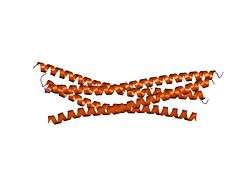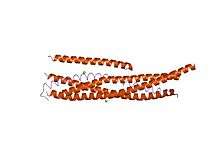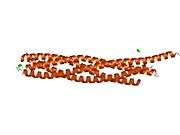STX1B
| View/Edit Human | View/Edit Mouse |
Syntaxin-1B is a protein that in humans is encoded by the STX1B gene.[3]
Interactions
STX1B has been shown to interact with UNC13B.[4]
References
- ↑ "Human PubMed Reference:".
- ↑ "Mouse PubMed Reference:".
- ↑ "Entrez Gene: STX1B2 syntaxin 1B2".
- ↑ Betz A, Okamoto M, Benseler F, Brose N (January 1997). "Direct interaction of the rat unc-13 homologue Munc13-1 with the N terminus of syntaxin". The Journal of Biological Chemistry. 272 (4): 2520–6. doi:10.1074/jbc.272.4.2520. PMID 8999968.
Further reading
- Li G, Alexander EA, Schwartz JH (May 2003). "Syntaxin isoform specificity in the regulation of renal H+-ATPase exocytosis". The Journal of Biological Chemistry. 278 (22): 19791–7. doi:10.1074/jbc.M212250200. PMID 12651853.
- Pérez-Brangulí F, Muhaisen A, Blasi J (June 2002). "Munc 18a binding to syntaxin 1A and 1B isoforms defines its localization at the plasma membrane and blocks SNARE assembly in a three-hybrid system assay". Molecular and Cellular Neurosciences. 20 (2): 169–80. doi:10.1006/mcne.2002.1122. PMID 12093152.
- Nagamatsu S, Nakamichi Y, Watanabe T, Matsushima S, Yamaguchi S, Ni J, Itagaki E, Ishida H (January 2001). "Localization of cellubrevin-related peptide, endobrevin, in the early endosome in pancreatic beta cells and its physiological function in exo-endocytosis of secretory granules". Journal of Cell Science. 114 (Pt 1): 219–227. PMID 11112705.
- Betz A, Okamoto M, Benseler F, Brose N (January 1997). "Direct interaction of the rat unc-13 homologue Munc13-1 with the N terminus of syntaxin". The Journal of Biological Chemistry. 272 (4): 2520–6. doi:10.1074/jbc.272.4.2520. PMID 8999968.
- Smirnova T, Miniou P, Viegas-Pequignot E, Mallet J (September 1996). "Assignment of the human syntaxin 1B gene (STX) to chromosome 16p11.2 by fluorescence in situ hybridization". Genomics. 36 (3): 551–3. doi:10.1006/geno.1996.0506. PMID 8884284.
- Smirnova T, Stinnakre J, Mallet J (October 1993). "Characterization of a presynaptic glutamate receptor". Science. 262 (5132): 430–3. doi:10.1126/science.8105537. PMID 8105537.
This article is issued from Wikipedia - version of the 6/5/2016. The text is available under the Creative Commons Attribution/Share Alike but additional terms may apply for the media files.





